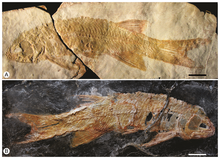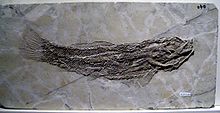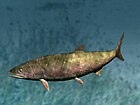할레코몰피
Halecomorphi| 할레코몰피 시간 범위: – Pre O S K N | |
|---|---|
 | |
| 백악기 cCipactlichthys scurtatus | |
 | |
| 아미아칼바(보우핀) | |
| 과학적 분류 | |
| 왕국: | 애니멀리아 |
| 문: | 챠다타 |
| 클래스: | 악티노프테르기 |
| 서브클래스: | 넵테르기 |
| 인트라클래스: | 홀로스테이 |
| Clade: | 할레코몰피 코프, 1872년 |
| 주문 및 패밀리[1] | |
할레코모르피는 네오프테리기 분지군에 속하는 가오리 지느러미 가시어류 분류군이다.유일하게 현존하는 할레코몰프는 보우핀(아미아칼바)이지만, 아미목(아미과, 카투리아과, 리오데스미다과, 시나미과 등)의 여러 과에서 멸종한 많은 종과 멸종한 이오노스코포과, 판시아니치티과, 파라세미오피스목(Panxianichytyformes)을 포함하고 있다.헤일코몰프의 화석 기록은 적어도 트라이아스기 초기까지 거슬러 올라간다.

파라세미오노타상 【왓슨누스】

이오노스코프상 【이오노코푸스】

아미폼 【카투루스】

반상 【칼라모플루스】

아미폼 【시나미아】

아미아 칼바의 두개골(보우핀)
할레코몰피는 가장 심하게 광물화된 비늘과 같은 조상들의 특징의 조합을 보여주지만, 특히 두개골의 구조에서 더 파생되거나 "현대적인" 특징에 의해서도 나타난다(예: 프리오퍼클의 위치와 모양).Halecomorphi의 고유한 파생 특성(시너포맷)은 다음과 같습니다.[2]
- 4중턱과 심플렉틱이 관절에 참여하는 독특한 턱 관절.
- 긴 등지느러미(일부 종)
- 후방 신체 부위의 세그먼트당 2개의 쌍추골(이형성 척추로 알려진 상태)
- 꼬리에 작은 뼈(하이퍼럴)를 배치한 것처럼 부채질합니다.
계통학 및 계통학
헤일코몰피의 체계적 위치에 대해서는 두 가지 가설이 있다.
- 할레코스토미 가설은 할레코모르피를 살아있는 네오프테리아인의 주요 집단인 텔레오스테이 자매 집단으로 제안하고, 홀로스테이의 [3]측계통법을 제시한다.
- Holostei 가설은 할레코모르피를 Gingingmodi의 자매 집단으로 제안하는데, Gingmodi는 Gars(Lepisosteidae)와 그들의 화석 친척들을 포함하고, 할레코스토미 측위법을 [4][5][6]만든다.
후자의 가설은 더 널리 [7][8][9][10]받아들여지고 있다.
| 넵테르기 |
| ||||||||||||
다음 분지도는[11] 멸종(단검으로 나타남)의 진화적 관계와 할레코몰피의 생물 질서를 요약한 것이다.
| 할레코몰피 |
| ||||||||||||||||||
레퍼런스
- ^ J. S. Nelson; T. C. Grande; M. V. H. Wilson (2016). Fishes of the World (5th ed.). Wiley. p. 752. ISBN 978-1-118-34233-6.
- ^ Ax, Peter [translated by Dr.Richard. E. Dunmur] (2010). "Halecomorphi — Teleostei". Multicellular Animals. Berlin: Gardners Books. pp. 207–210. doi:10.1007/978-3-662-08874-6_29. ISBN 978-3-642-05515-7.
- ^ 패터슨 C.홀로스틴의 상호관계.수신: 그린우드 P H, 마일즈 RS, 패터슨 C, eds물고기의 상호 관계.Zool J Linn Soc, 1973, 53 (공급) : 233 ~ 305
- ^ Olsen P. E. (1984). "The skull and pectoral girdle of the parasemionotid fish Watsonulus eugnathoides from the Early Triassic Sakemena Group of Madagascar with comments on the relationships of the holostean fishes". J Vertebr Paleontol. 4: 481–499.
- ^ Grande, Lance; Bemis, William E. (1998). "A Comprehensive Phylogenetic Study of Amiid Fishes (Amiidae) Based on Comparative Skeletal Anatomy. an Empirical Search for Interconnected Patterns of Natural History". Journal of Vertebrate Paleontology. 18 (sup001): 1–696. doi:10.1080/02724634.1998.10011114.
- ^ López-Arbarello, Adriana; Sferco, Emilia (March 2018). "Neopterygian phylogeny: the merger assay". Royal Society Open Science. 5: 172337. doi:10.1098/rsos.172337.
- ^ Betancur-R (2016). "Phylogenetic Classification of Bony Fishes Version 4".
- ^ Nelson, Joseph, S. (2016). Fishes of the World. John Wiley & Sons, Inc. ISBN 978-1-118-34233-6.
- ^ "Actinopterygii". Integrated Taxonomic Information System. Retrieved 3 April 2006.
- ^ R. Froese and D. Pauly, ed. (February 2006). "FishBase".
- ^ Sun, Zuoyu; Tintori, Andrea; Xu, Yaozhong; Lombardo, Cristina; Ni, Peigang; Jiang, Dayoung (April 2017). "A new non-parasemionotiform order of the Halecomorphi (Neopterygii, Actinopterygii) from the Middle Triassic of Tethys". Journal of Systematic Palaeontology. 15 (3): 223–240. doi:10.1080/14772019.2016.1181679.
- Brian J. Gardiner, John G. Maisey, D.팀 J. 리틀우드:기초 Neopteryians의 상호관계.S. 117-146인치: Melanie L. J. Stiassny, Lynne R. Parenti, G. David Johnson (Hrsg):물고기의 상호 관계.Academic Press, 1996년 ISBN 0-12-670950-5








